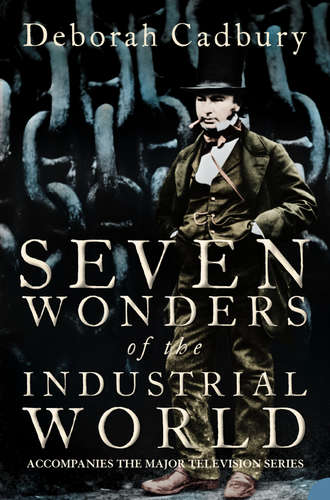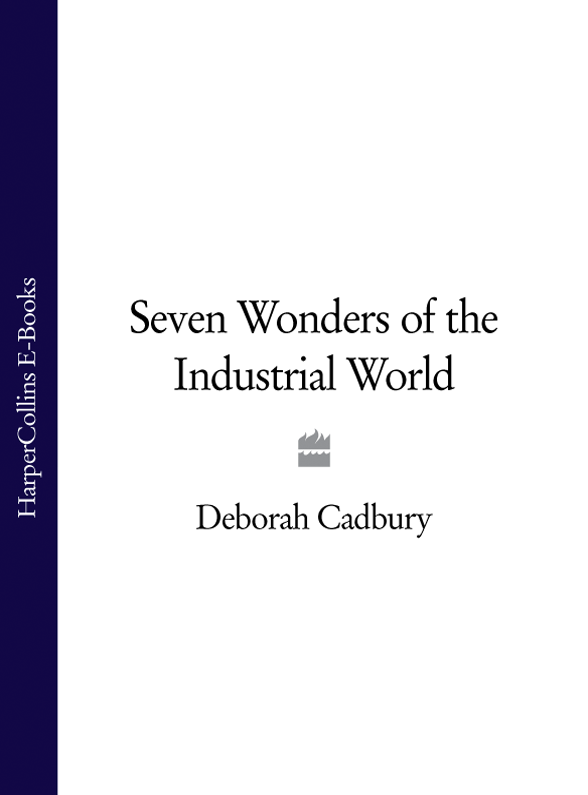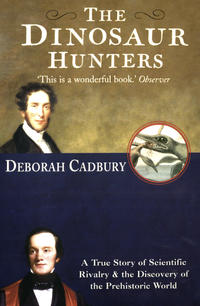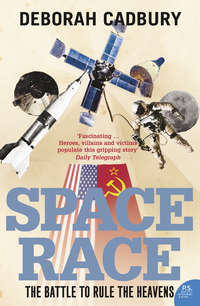
Полная версия
Seven Wonders of the Industrial World


SEVEN WONDERS
OF THE
INDUSTRIAL WORLD
Deborah Cadbury

Contents
Cover
Title Page
Introduction
1 The Great Eastern
2 The Bell Rock Lighthouse
3 The Brooklyn Bridge
4 The London Sewers
5 The Transcontinental Railroad
6 The Panama Canal
7 The Hoover Dam
Bibliography and Sources
Index
Acknowledgements
About the Author
Other Works
Copyright
About the Publisher
Introduction
The great achievements celebrated in this book reveal as much about the human spirit as they do of technological endeavour. The period of over 125 years from the beginning of the nineteenth century saw the creation of some of the world’s most remarkable feats of engineering, now celebrated as wonders of the world, from Isambard Kingdom Brunel’s extraordinary Great Eastern, the ‘Crystal Palace of the Seas’ that he hoped would join the two ends of the British empire, to the Panama Canal, that linked the Atlantic and Pacific oceans in 1914.
The slowly evolving Industrial Revolution was the fertile ground that gave life to these dreams in iron, cement, stone and steel. The pioneers of the age were practical visionaries, seeing beyond the immediate horizon, the safe and the known; taking risks and taking society with them as they cut a path to the future. Yet their unique masterpieces could never have been built without an army of unsung heroes, the craftsmen and workers also willing to take risks as they laboured to bring each dream to life. And as each great scheme unfolded, the financiers and shareholders were there too, caught up in the exuberant process and hanging on for the ride as reputations were lost and won.
The Bell Rock Lighthouse – the oldest ‘wonder’ featured in this book – was created while Britain was in the grip of the Napoleonic wars. In 1807, Robert Stevenson, the grandfather of Robert Louis Stevenson who wrote Treasure Island, started work on the Bell Rock Lighthouse in wild northern seas off the east coast of Scotland. For years he had longed to make his mark on the world, bringing light to the treacherous Scottish coast. He dreamed of taking on the most dangerous place of all: the Bell Rock, a large reef eleven miles out to sea positioned right in the middle of the approach to the safe haven of the Firth of Forth. Over the centuries, this deadly reef, submerged at high tide, had cost so many lives it ‘breathed abroad an atmosphere of terror’ along the whole coast.
Like so many pioneers of the Industrial Revolution, Stevenson had cheap labour available, men desperate for work and often prepared to risk their lives for a meagre wage. This was a time when coal and iron ore were mined by hand and canals were dug with picks and shovels. The cotton factories, railways, shipbuilding: all needed a plentiful supply of labour. The population was rising rapidly, in England and Wales alone from under 7 million in 1750 to 18 million a century later. And because of recent improvements in agricultural husbandry, rich landowners and farmers could now produce more with fewer workers. As the rich enclosed their land and the old medieval field strips worked by a peasant population for centuries disappeared, a new landless class labouring for a wage emerged.
The opportunities of the town beckoned, drawing wave upon wave of willing recruits. During the nineteenth century the major cities grew, doubling and redoubling like cells dividing. Yet at this stage, industrialisation had yet to bring real benefits to the working man. Even after the 1832 Reform Act, a working man had few rights; he was unlikely to qualify for the vote and government sympathies lay with his employers. Just moving to one of England’s growing cities could lower life expectancy, which for a labourer was rarely much more than 35 years, and in some cities, like London or Liverpool, lower still. Many women died giving birth and although there were wide variations, records show that in cities like Manchester almost 60 per cent of children from poor families did not reach five years of age, dying mostly from infectious diseases. The poor often lived in such pitiful squalor; sometimes several families sharing a single room. Wages were low; there were no unions, pensions or social security and no minimum age for labour. Amongst the poorest families everybody was obliged to work: men, women and children.
Children as young as nine or ten were employed in building Isambard Kingdom Brunel’s colossal ship, the Great Eastern, which was built on the banks of the Thames between 1853 and 1858. They were essential, working in the confined space of the unique double hull of this grand ship, heating and handling thousands of white-hot rivets. Horrific accidents were all too frequent but a death simply meant that there was employment for another child and there was no shortage of willing workers. There is a noticeable absence of records though – the names and wages of the unsung labourers not even worthy of a note in the minute books of the great companies or journals of leading men.
Brunel hoped the Great Eastern would be his masterpiece, which would link the ends of the empire. At a time when most ships moored in the Thames were nearer 150 feet in length, built to traditional designs in wood and powered by sail, Brunel’s ‘Great Ship’ was almost 700 feet long, a floating island made of iron, that he envisaged could carry 4,000 passengers in magnificent style as far as the Antipodes without needing to refuel. This ‘Crystal Palace of the Seas’ broke the mould of convention; the design was revolutionary with a double hull that made it unsinkable and powered by enormous engines as high as a house. Every part of the ship’s design had been subject to Brunel’s penetrating scrutiny and so complex was the technology that it was claimed only he understood it entirely. He faced enormous criticism: his ship was too big, it was too expensive, it would sink, or break its back on the first big wave, if, that is, he could actually manage to launch it on to the Thames. In fact, it was the blueprint for ship design for years to come.
As the Great Eastern became the talk of England, people came to gaze in disbelief at its vast proportions as it miniaturised the working world around it. Even Queen Victoria herself was tempted to venture down the Thames to visit the ship that symbolised the ‘moral superiority’ of her empire. Yet records show that as she sailed down the Thames to visit the site she was obliged ‘to smell her nosegay all the time’. For while Brunel was building his masterpiece, the city was in crisis. London was drowning in a sea of excrement.
There were some 200,000 cesspits across the capital but as the population escalated in the first half of the nineteenth century, so did the smell. In poor districts these cesspits were seldom emptied, leaving the sewage to overflow, seeping through cracks in floorboards or even running down walls, spreading everywhere with its creeping tentacles of disease. Three epidemics of cholera had swept through London by 1854 leaving over 30,000 dead. The desperation of the poor of the East End even reached The Times in a famous protest: ‘Sur, – May we beg and beseech your proteckshion and power … We live in muck and filthe. We aint got no privies, no dust bins, no drains, no water splies, and no drain or suer in the hole place … The Stenche of a Gully-hole is disgustin. We all of us suffur, and numbers are ill, and if the Colera comes Lord help us …’
In the summer of 1858, while the Great Eastern was being fitted out for her maiden voyage, the ‘great stink’ finally became unbearable. Joseph Bazalgette, Chief Engineer of the Metropolitan Board of Works, proposed a grand scheme to build 82 miles of intercepting sewers, a sewage superhighway that linked with over 1,000 miles of street sewers to provide an underground network beneath the city streets. He drove himself to the limits of endurance struggling underneath London’s dense housing to create the world’s first modern sewage system. The task was made even more difficult since he was in competition with the new underground railway, a network of roads and the emerging overland railway systems. But his ambitious design transformed the city into the first modern metropolis, setting a standard that was quickly copied the world over.
While an endless supply of cheap labour was the human capital for many projects such as the London sewers and the Great Ship, this workforce needed new materials to build for a new age. The iron industry was booming and formed the basis of the Industrial Revolution. During the eighteenth century, output had been modest with the indigenous ore in England of such low grade that it took nearly seven tons of coal to refine one ton of iron, but by the mid-nineteenth century, improvements, particularly in the use of steam power for blast furnaces, enabled a better quality product to be made more economically. The search for coal and iron ore was ceaseless; by the 1850s a new blast furnace was opened every two weeks.
The railways were the first of the big adventures in iron. With the invention of the steam engine and the laying of track came untold wealth as the countryside was opened up and cities were linked, the new roaring engines shrinking space. Suddenly the country was mobile. Only 500 miles of track had been laid in 1838. Less than fifteen years later, by the time of the Great Exhibition in 1851, over 6,000 miles of track criss-crossed the country.
The golden age of railways in Britain was overtaken by the phenomenal growth of railways in America. In the early part of the nineteenth century the vast continent lay as it had for centuries, marked only by Indian and buffalo trails and the worn wagon tracks of those making the journey west. The eastern and western states of America were still separated by a harsh wilderness that took around six months to cross by wagon. Many preferred to make the journey to California by sea, braving a voyage around South America’s Cape Horn rather than risking the dangerous overland crossing. In 1830, when the first American-built locomotive, Tom Thumb, came into service, there were only 30 miles of working track in the United States. Growth was so fast that by 1850 there were over 9,000 miles of track and, by 1860, a staggering 30,600.
The Transcontinental Railroad was built with government help during and after the Civil War in the 1860s, and opened up the continent more quickly than a prairie fire, allowing the virgin acres to be settled. President Lincoln was determined on a railway line across the continent, which ‘was imperatively demanded in the interests of the whole country’. There were two teams, one began building from the east and the other from California in the west. Of the large numbers who drove the railways across America, the Chinese fared particularly badly, perishing in their thousands in the difficult terrain of the Sierras, their nameless bones gathered and shipped back to China by the crate load. In 1869, after seven years, the tracks joined, shrinking the whole continent as the journey from New York to San Francisco could now be done in a matter of days. In a record-breaking run, in 1876, tracks were cleared for the Lightning Train, which raced from coast to coast in just 83 hours. As President Lincoln had envisaged, the Transcontinental Railroad became a catalyst for the vast expansion that would help to make America the industrial giant of the world.
With the growth in cities and improvements in transport, the demand for goods grew. Commerce prospered, trade increased and more goods were exported. The relentless quest for profit created new wealth and capital, which in turn sought outlets and opportunities for further gain. There was a need to import more raw materials and export the growing surplus of manufactured goods. Since the medieval period wool had traditionally been the major trading commodity with Europe, but this had fallen away. In its wake there came a demand for more exotic goods to trade in Europe for iron ore and timber. The more adventurous among the merchant traders were landing sugar and cotton, spices and tobacco from the West Indies and America.
With the boom in world trade, by the late nineteenth century shipping was big business. In Egypt the Suez Canal had shortened the journey to India, Australia and the Far East, making trade easier and cheaper, and the world itself a smaller place. Having completed the Suez Canal in 1869, French entrepreneur Vicomte Ferdinand de Lesseps dreamed of an even bolder scheme. He would cut a path across the Isthmus of Panama and unite the great oceans of the Atlantic and Pacific ‘from sea to shining sea’. The long and dangerous journey around South America and Cape Horn would become a thing of the past. Ferdinand de Lesseps’s dream became a symbol of French national pride in the 1880s and thousands flocked to help with construction. But once out in the tropical heat of Panama, they found themselves facing impenetrable jungle, deep swamps and deathly tropical diseases as it proved to be an undertaking of nightmare proportions. With over 20,000 dead and the investors bankrupted, the canal company failed in 1889 and de Lesseps died a defeated man, soon after. Twenty-five years later, the Americans under Colonel George Goethals finally completed the project, opening up new regions for the ever-increasing world trade.
By the 1880s, in spite of the enormous wealth created by the Industrial Revolution in Europe, there were still large numbers in poverty who had not benefited at all. The American economy, however, was growing rapidly, exporting grain and manufactured goods to Europe. And there were plenty in Europe who dreamed of returning on these ships to reach the promised land of America. They had heard of the Statue of Liberty with the words etched on it: ‘Bring me your poor …’ They came from Ireland to escape the potato famine, from England looking for a better life, from Russia escaping the pogroms. Growth in America was so rapid that the population increased tenfold, from 4 million in 1790 to over 40 million by the time of the Centennial Exhibition of 1876.
One such immigrant was John Augustus Roebling, from Mühlhausen, Germany, a brilliant engineer who won the contract to build the biggest bridge in the world across the wide and turbulent East River, which separates New York from Brooklyn. Roebling’s Brooklyn Bridge would be a suspension bridge of great strength and exquisite symmetry: the crowning achievement of his career. The foundations alone would reach more than 70 feet below the river, its two mighty towers, at 276 feet, would dwarf much of New York. The total length of almost 6,000 feet seemed a miracle, and all to be built out of a new material: steel.
But this ambitious dream was to cost him the extreme price of life itself, and, unknowingly, he condemned his son to a shadow life. Determined to continue with his father’s vision, Washington Roebling had to face a mysterious new disease, ‘caisson disease’, or, as it is now known, the bends. As he and his team laboured deep beneath the East River in the hot, humid underground world of the caissons, no one knew who might be struck down next with the terrifying symptoms, paralysis or even death. Eventually Washington Roebling succumbed to the mysterious new disease. He was too weak to leave his room and could only continue his work on the bridge by dictating his instructions to his wife, Emily. As the great network of cables was spun across the great East River he watched through a telescope from his window.
‘During all these years of trial and false report,’ declared one leading official in his praise at the opening ceremony on 24 May 1883, ‘a great soul lay in the shadow of death, praying only to stay long enough for the completion of the work to which he devoted his life.’ It had taken fourteen years to build the Brooklyn Bridge but now it transformed the New York landscape and became a triumphant symbol of what men could achieve. As the public fell in love with the sheer American audacity of the enterprise, the heroism cemented into its very fabric, it came to represent ‘a monument to the moral qualities of the human soul’.
With improvements in travel and the growth in prosperity, people found their way across the vast continent. They marked the empty plains with their communities, building the first towns, selling the virgin land, creating a country, only stopped by a poor or hostile environment, such as the desert regions of Arizona and Nevada. And even here in a region so bereft of life, in the early 1900s, Arthur Powell Davis of the US Bureau of Reclamation realised it would be possible to make the desert bloom. He dreamed of harnessing the Colorado River as it gouged its way for 1,400 miles through snowy heights and forbidding canyons and turning the wild spirit of the unruly river into an obedient force for good.
The scale of the enterprise was so vast that it took years to win financial backing and government support. Everything about it broke records. As tall as a sixty-storey building and with a larger volume than the Great Pyramid at Giza, the Hoover Dam, begun in 1931, was the biggest dam in the world. At the height of the Depression, poverty-stricken workers earning just a few dollars a day died from horrific explosions, carbon monoxide poisoning and heat exhaustion. It was chief engineer Frank Crowe, with his skilled management, who built it ahead of schedule and under budget, and who, in doing so, created one more industrial wonder for the modern world.
By the time President Roosevelt inaugurated the Hoover Dam in 1935, the last ‘wonder’ described in this book, the world was transformed in almost every way possible. People’s standard of living had increased greatly, average life expectancy had almost doubled in the West and infant mortality had virtually disappeared. Other systems of transport had been developed too, including the automobile which gave many people their own private transport. Higher education and specialist training opened up new opportunities for those whose forebears, a few generations before, had been labouring in fields unable to read or write. The £1 a week that Robert Stevenson had given his labourers to work a twelve-hour day, seven days a week, wet or dry, had by the time the Hoover Dam was lighting up the western deserts turned into a wage that a working man, increasingly backed by unions, could live on more comfortably.
The stories in this book capture the restlessness and ambition of an age and also represent a high watermark of industrial achievement. Each ‘wonder’ illustrates the swiftly moving frontiers of technology, and serves as a unique monument, a marker for what was known at the time. Taken together, the wonders illustrate progress by charting the frontiers of industrial knowledge and expertise. Timing is critical; it is no accident that these particular stories occurred when they did. It would not have been possible to create a Hoover Dam or a Panama Canal earlier in the nineteenth century. Indeed, the French tried and failed in Panama since the technology and infrastructure to create the canal were not in place. The changes are not linear; history is not about a smooth, even progression. There were enormous bursts of creative endeavour and change that reached out in unexpected directions until what was once barely possible became routine.
In one sense the stories present a romantic view of man – of an individual who struggles to realise his dream and make a mark on the world. As the nineteenth century progressed the men of genius took the stage in quick succession, each engrossed in his own creation to the exclusion of all else. Each in turn gave so much of himself, often denying relationships, sleep, basic human comforts and ultimately, in some cases, their health, to the demands of their creative work. Robert Stevenson struggled in dangerous seas to create his lighthouse, which is the oldest offshore lighthouse still standing anywhere in the world, a testimony to his battle with the sea. The Roeblings – father and son – were prepared to give their very lives to the Brooklyn Bridge, whose perfect symmetry and beauty have inspired poets and artists. And Brunel was in the very midst of the Industrial Revolution, seemingly directing it himself, throwing his small, energetic figure into the great mélange, absorbed in the delight of it all, unable to tear himself away from his Great Ship, no matter what was the price to be paid.
The legacy of their great ambition and talent remains to this day. With the exception of Brunel’s Great Ship, all the wonders have survived to the twenty-first century and are now celebrated as powerful symbols of the modern world. The wealth of inspiration and energy of the nineteenth century was the catalyst for the huge progress that marked the twentieth century as the coming industrial giants stood on the shoulders of an earlier generation.
1 The Great Eastern
‘I have never embarked on any one thing to which I have so entirely devoted myself, and to which I have devoted so much time, thought and labour, on the success of which I have staked so much reputation …’
Isambard Kingdom Brunel on the Great Eastern, 1854
IN 1857, ISAMBARD KINGDOM BRUNEL, Britain’s foremost engineer, paused one day for a photograph in Napier shipyard at Millwall in east London. Cigar in mouth, with mud caked on his shoes and trousers, this is no formal photograph. He has his hands in his pockets, his clothes are creased, his hair untidy. The face and, particularly, the eyes are absorbed in something that can only be imagined, something that occupies him completely. He looks like a man with a future.
Brunel was at the peak of his fame, his latest venture had become the talk of England. Behind him rose the massive dark shape of the hull of the Great Eastern, the largest ship in the world, the Leviathan of her day. Expectant sightseers from across Europe came to see her on the banks of the Thames, where she rose, wrote Charles Dickens, ‘above the house-tops, above the tree-tops, standing in impressive calmness like some huge cathedral’. Nothing like this had been seen before; when complete, she would be the largest moving man-made object ever built and, for many, a symbol of the greatness of the British Empire. Yet far from being the final triumph in Brunel’s brilliant career, the Great Eastern was to become the monstrous creation that would destroy him.
Brunel’s grand scheme had begun to take shape a few years earlier, shortly after the Great Exhibition of 1851. Britain had seen a spectacular boom in the railway industry, with over 6,000 miles of track laid since the 1830s. Brunel himself, caught up in the thick of railway mania, was increasingly disillusioned by it. ‘The whole world is railway mad,’ he protested to a friend. ‘I am really sick of hearing proposals made.’ Among his sketches for Paddington Station in London in 1852, his notebooks reveal drawings of his next bold venture: a great steamship, almost twice the length of any ship ever built.
He dreamed of a floating city, majestic by day and a brilliant mirage at night, reflecting a million lights in the dark water. It was to be a ship of such vast and unheard of proportions that she could carry 4,000 passengers in pampered luxury as she steamed through distant seas. In the evening there would be dancing under sparkling chandeliers, or a stroll on deck in especially manufactured ‘moonlight’ as she pursued her steady course to the Antipodes magically, without need of refuelling. But could Brunel ever realise his dream and build the ‘Crystal Palace of the Seas’? And who could afford to support him?






